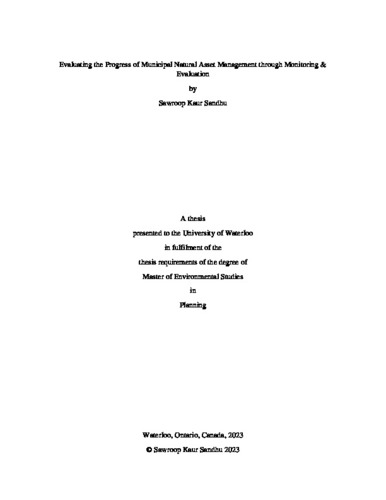| dc.contributor.author | Sandhu, Sawroop | |
| dc.date.accessioned | 2023-09-29 13:44:18 (GMT) | |
| dc.date.available | 2023-09-29 13:44:18 (GMT) | |
| dc.date.issued | 2023-09-29 | |
| dc.date.submitted | 2023-09-18 | |
| dc.identifier.uri | http://hdl.handle.net/10012/19980 | |
| dc.description.abstract | Contemporary environmental and land-use planning in many Canadian municipalities is challenged with two key problems that have grown with increasing urban development: 1) natural ecosystems decline and 2) grey infrastructure service failure. The 2020 Living Planet Report Canada highlighted the continuing decline of many natural ecosystems in remote areas and near to sprawling Canadian cities. These risks are heightened, with the possibility of climate change-driven extreme weather resulting in grey infrastructure failure. A possible approach for slowing or reversing these concerns is the use of ecosystem services provided in the form nature-based solutions (NBS). An emerging NBS practice is the implementation of Natural Asset Management (NAM). NAM is being applied by municipalities, insufficient monitoring is causing a lack of evidence that would be required to demonstrate NAM’s ability to counter ecosystem decline and grey infrastructure service loss.
We applied a standardized evaluation framework to assess NAM progress in six case-study municipalities in Canada. Data were collected with extensive review of municipal documents (e.g., Official Plan changes, Council meeting notes, budget allocations) and interviews with key municipal decision-makers. Data analysis was performed through thematic coding. The analysis reveals that while many municipalities are increasing their awareness and capacity for NAM implementation, large barriers to progress remain including limited enabling policies and lack of effective municipal governance. Especially changes in government and administrative organization tend to undermine the required long-term efforts in support of NAM. Municipalities must overcome these barriers to allow further progress towards restoration and conservation of natural assets that would improve the state of urban natural ecosystems and urban service delivery. An increasingly engaged public might provide pressure on municipalities to enhance permanence of NAM efforts and require accountability for NAM progress. | en |
| dc.language.iso | en | en |
| dc.publisher | University of Waterloo | en |
| dc.subject | Natural Asset Management (NAM) | en |
| dc.subject | Nature-based Solutions (NbS) | en |
| dc.subject | Land-use Planning | en |
| dc.title | Evaluating the Progress of Municipal Natural Asset Management through Monitoring & Evaluation | en |
| dc.type | Master Thesis | en |
| dc.pending | false | |
| uws-etd.degree.department | School of Planning | en |
| uws-etd.degree.discipline | Planning | en |
| uws-etd.degree.grantor | University of Waterloo | en |
| uws-etd.degree | Master of Environmental Studies | en |
| uws-etd.embargo.terms | 0 | en |
| uws.contributor.advisor | Drescher, Michael | |
| uws.contributor.affiliation1 | Faculty of Environment | en |
| uws.published.city | Waterloo | en |
| uws.published.country | Canada | en |
| uws.published.province | Ontario | en |
| uws.typeOfResource | Text | en |
| uws.peerReviewStatus | Unreviewed | en |
| uws.scholarLevel | Graduate | en |

